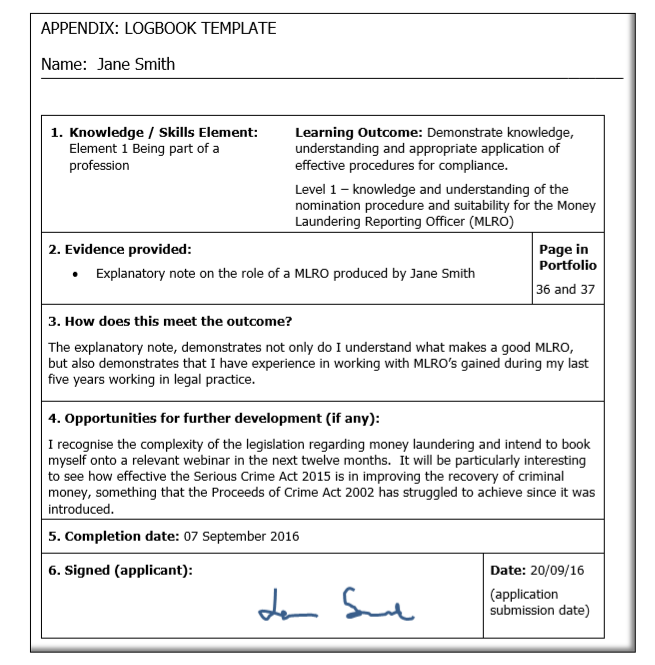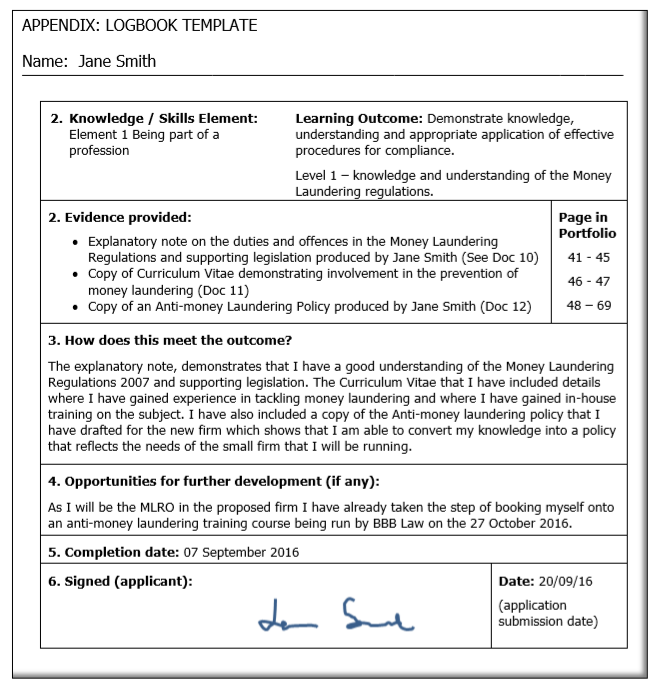This shows how you can use a combination of Option 1 and Option 2 to demonstrate competence. It is normally used where the applicant has attended a course which covers part of the Learning Outcome but not all of it. The applicant’s knowledge and understanding of the aspects of the Learning Outcome not covered in sufficient depth by the course are then demonstrated by a logbook entry and supporting evidence.
The following example shows how this option could be used to evidence competence at Level 1 for one Learning Outcome in the Practice Management Competency Framework.
Learning Outcome: Demonstrate knowledge, understanding and appropriate application of effective procedures for compliance.
| Aspect of the Learning Outcome that needs to be demonstrated | The information that should be included if using this option | Examples of possible supporting documentation |
| Knowledge and understanding of the nomination procedure and suitability for the Money Laundering Reporting Officer (MLRO) | Here the course covers aspects of the money laundering legislation that relate to the role of an MLRO, but does not specifically cover the nomination procedure. Therefore the applicant has linked their learning from this course into a logbook entry that also explains what attributes would make a person an ideal candidate to be an MLRO. | Doc 1: Course certificate |
| Doc 2: Course syllabus | ||
| Doc 3: Logbook entry | ||
| Doc 4: Supporting note | ||
| Knowledge and understanding of the Money Laundering regulations | Here the course covers the money laundering legislation but not in sufficient depth to fully meet this particular element of this level of the Learning Outcome. To overcome this, the applicant has also supplied a logbook entry accompanied by a supporting note and a copy of an Anti-Money Laundering Policy that she has drafted. | Doc 1: Course certificate |
| Doc 2: Course syllabus | ||
| Doc 5: Logbook entry | ||
| Doc 6: Supporting note | ||
| Doc 7: AML Policy |
Where you are relying in part on a course you must submit:
- A copy of the course completion/ attendance certificate
- A sufficiently detailed course syllabus relevant to the date that you took the course
It is your responsibility to identify the section of the syllabus that you believe covers this element of the Learning Outcome at this level. On occasions the syllabus will not provide sufficient detail to demonstrate it fully covers the particular aspect of a Learning Outcome; if this is the case you should provide a copy of the course notes produced by the training organisation. You should clearly identify the specific parts of the course notes which demonstrate compliance with the Learning Outcome.
Doc 1: Certificate of attendance on the course
The course certificate must:
- Evidence that you completed the course
- Show the date(s) that you attended the course
- Identify the name of the body providing the training
- Show the course title so this can be referenced to the syllabus
Doc 2: Course syllabus or extract from a course syllabus
The syllabus must:
- Be supported by a course certificate showing that you have completed the course
- Be applicable to the date that you took the course. If you attended the course in 2012 you will not be able to use a 2016 syllabus unless the course provider is able to validate that the course has not changed
- Must fully cover the aspects of the Learning Outcome that you are evidencing. If it doesn’t you will have to use option 3 (a combination of course(s) and logbook entries)
- Be sufficiently detailed. If the syllabus in not sufficiently detailed you will ask to provide course notes.
The onus is on you to point out how the course covers the Learning Outcome. Therefore if you are relying on a lengthy syllabus document or course notes please indicate to the assessor which sections of the syllabus / course notes cover the aspects of the learning outcome.
Doc 3: Logbook entry
- Element 1: Being part of a profession
Learning Outcome: Demonstrate knowledge, understanding and appropriate application of effective procedures for compliance
Level 1: Knowledge and understanding of the nomination procedure and suitability for the Money Laundering Reporting Officer (MLRO)

Doc 4: Explanatory note referred to in the logbook entry covering the role of the Money Laundering Reporting Officer (MLRO).
The explanatory note should:
- Explain in detail the role of the MLRO
- Explain the attributes that would make a person suitable to be appointed as an MLRO
- If possible the applicant could provide examples of MLROs that they have worked with, describing what made them suitable for the role
Doc 5: Logbook entry
- Element 1: Being part of a profession
Learning Outcome: Demonstrate knowledge, understanding and appropriate application of effective procedures for compliance
Level 1: Knowledge and understanding of the Money Laundering regulations

Doc 6: Explanatory note on the duties and offences in the Money Laundering Regulations and supporting legislation
Here the applicant will use the explanatory note to evidence their knowledge and understanding of the Money Laundering Regulations. It should therefore include the following:
- The scope of the Money Laundering Regulations 2007. This should include a description of what constitutes the regulated sector
- Detail on the duties in the Money Laundering Regulations 2007 placed on the regulated sector
- Explain how the Money Laundering Regulations 2007 links to the Proceeds of Crime Act 2002. In particular it should cover in detail the offences and defences
Doc 7: Anti-money Laundering Policy drafted by the applicant for the firm she is seeking to have authorised.
A good example of an Anti-money Laundering Policy would include the following elements:
- Introduction detailing the purpose of the policy and its scope
- Policy section detailing the firm’s policy in relation to all aspects of anti-money related work
- Anti-money Laundering Guidance section, explaining:
o The offences and defences
o The duties the Money Laundering Regulations place on the firm
-Detail on Customer Due Diligence checks
-Record keeping
-Implementation and review of policies and procedures
-Training
o The Money Laundering Reporting Officer, their role and how they can be contacted
- A section on how to identify potential money laundering
- Copy of the firm’s Customer Due Diligence Procedure
- Copy of the firm’s Procedure for the reporting of suspected or attempted money laundering
- Copy of the firm’s disclosure documentation


